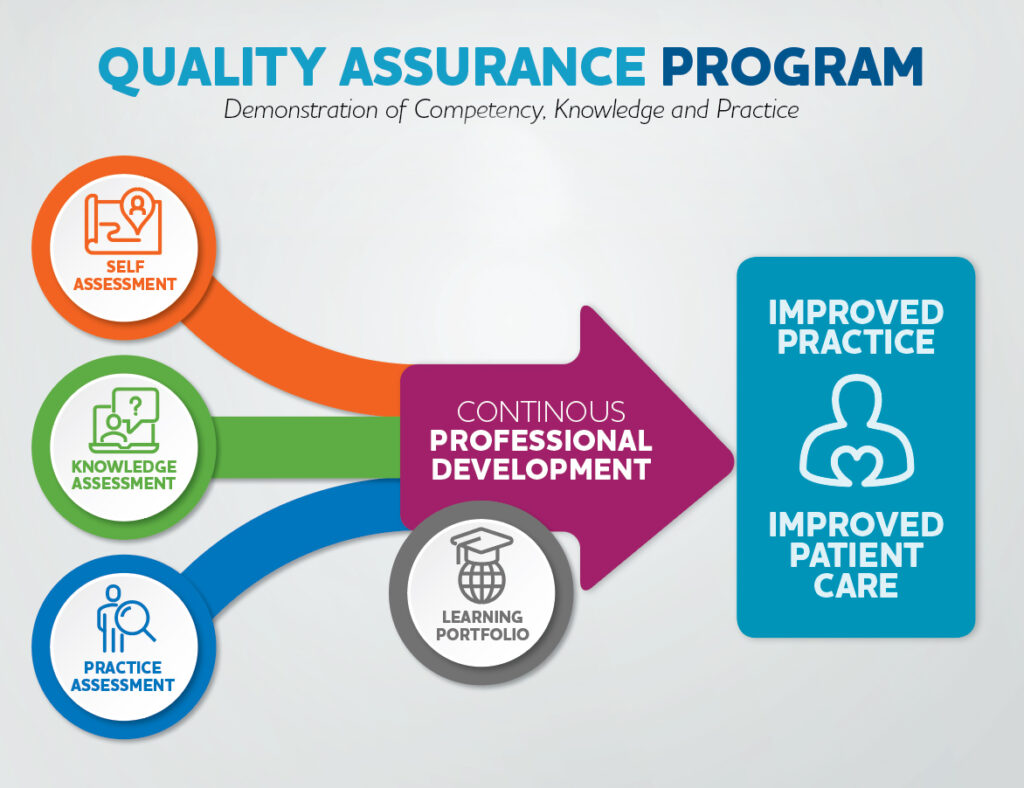Part of the College’s commitment to protecting the public is helping to ensure that pharmacy professionals maintain appropriate skills and knowledge throughout their career. The Quality Assurance (QA) Program assures the public that pharmacists and pharmacy technicians are practicing to the standards of the profession, and are engaged in safe and quality care. Through the QA Program, the College has a dual mandate:
- For those registrants who are not meeting standards, to identify their gaps and help them remediate
- For those registrants who are meeting standards, to validate the things they are doing well and to assist in improving practice
A HOLISTIC APPROACH TO QUALITY ASSURANCE
In building its QA Program, the College started with the question, “What does competency mean?” Essentially, competency is comprised of what a registrant “can do” (i.e. has required the knowledge, skills and attitude) and what a registrant “does do” (i.e. engages in the right processes in practice) in order to provide a complete picture of an individual’s overall competency. The next questions in developing the QA program were “How do professionals maintain competency in these areas?” and “How can the College measure a registrant’s maintenance of competency in these areas?”
QA PROGRAM COMPONENTS
With the ultimate and long-term goal of all quality assurance activities enhancing patient outcomes, the QA Program components work together to drive this goal forward by ensuring pharmacy professionals have up-to-date knowledge and skills and are engaging in the right patient care activities.
The four components of the QA Program are:
- Learning portfolio: independently engaging in ongoing professional development to maintain competency and advance practice based on specific place of practice and patients
- Self-assessment: identifying learning needs to inform self-directed professional development
- Knowledge assessment: focusing on knowledge and skills needed to provide appropriate care through a standardized computer-based assessment
- Practice assessment: focusing on the processes used to deliver patient care through conversation with a College practice advisor at the place of practice
Learn more about the College’s QA Program components in “Quality Assurance: Supporting Safe and Quality Care.”
NAPRA Competencies and College Assessments
The table below indicates how the National Association of Pharmacy Regulatory Authorities’ Professional Competencies for Canadian Pharmacists at Entry to Practice align with the assessments completed as part of the QA Program, as well as part of the College’s assessments of pharmacies. As illustrated by the table below, no single assessment addresses all of the competencies; multiple assessments are needed so that they can work together to address the various competencies.
| NAPRA Competencies for Pharmacists | Practice Assessment | Knowledge Assessment | Future Development | Pharmacy Assessment (not part of QA Program) |
|---|---|---|---|---|
| Ethical, Legal & Professional Responsibilities | X | X | X | |
| Patient Care | X | X | ||
| Product Distribution | X | |||
| Practice Setting | X | |||
| Health Promotion | X | |||
| Knowledge & Research Application | X | X | ||
| Communication & Education | X | X | ||
| Intra- and Inter-Professional Collaboration | X | |||
| Quality & Safety | X |
Note: The Competencies are used instead of the Model Standards of Practice for Canadian Pharmacists as they were more recently updated.
APPLYING A RIGHT-TOUCH AND RISK-BASED APPROACH
The QA Program incorporates a right-touch, risk-based approach that supports the College’s mandate of public protection. For the majority of registrants who are meeting standards, the College validates the work they are doing well and helps identify areas for improvement. For the small percentage of registrants who are not meeting standards, the College focuses on helping them access appropriate remediation.
Right-touch means that the College focuses quality assurance activities on those things that will make the biggest difference for patients (i.e. assessments to ensure that pharmacy professionals have the right knowledge and skills and are applying these in practice). The risk-based approach focuses on activities or behaviours that have the highest risk for patients and identifies registrants for whom remediation is necessary. For example, with the existing practice assessment, only registrants who do not meet the standards after two separate practice assessments are required to undergo a quality assurance assessment that involves evaluation and remediation by the Quality Assurance Committee.
Ultimately, the QA Program is meant to be educational and collaborative, not punitive. This approach benefits both patients, through better health outcomes, and pharmacy professionals, through ongoing skill and knowledge development, validation of their practice, and support to identify areas for improvement.














